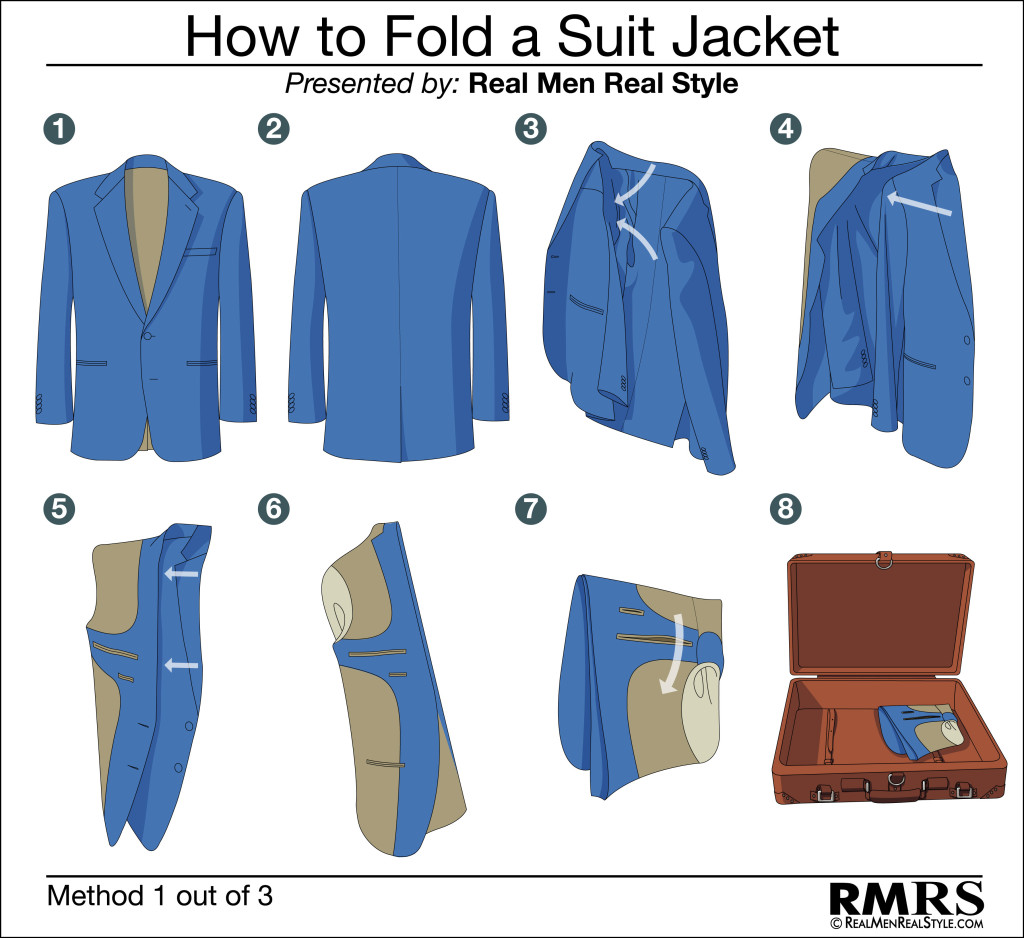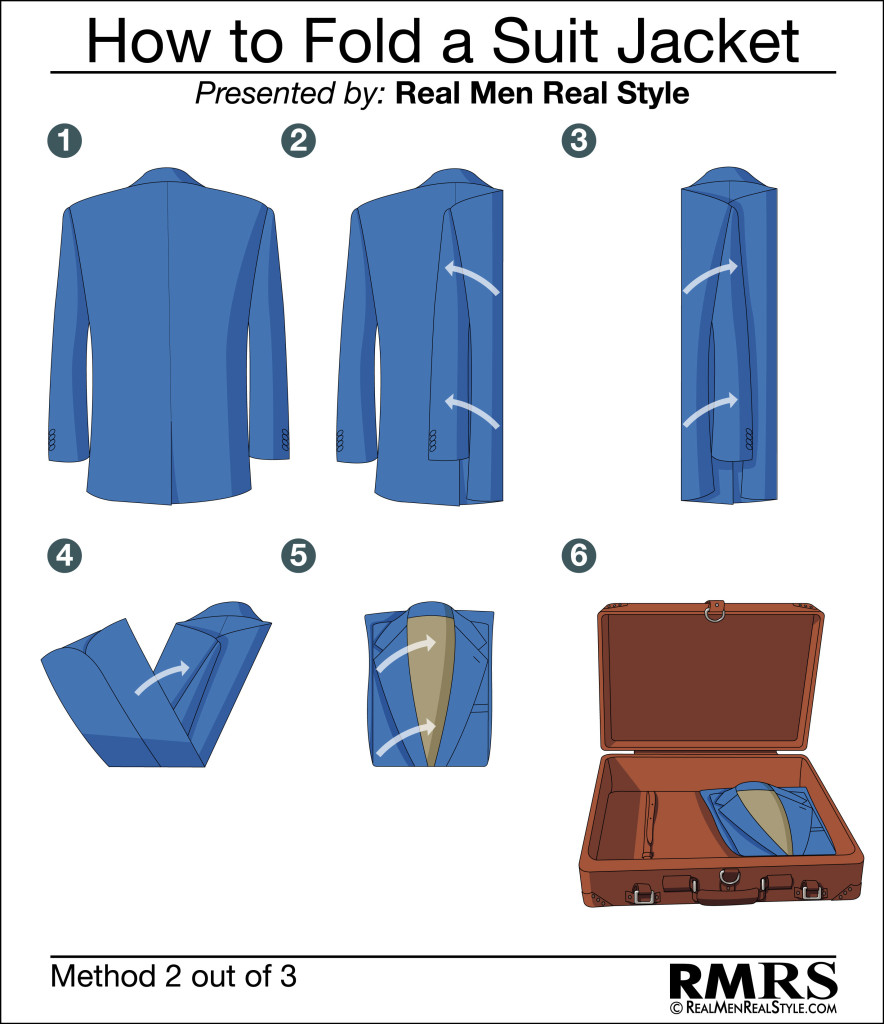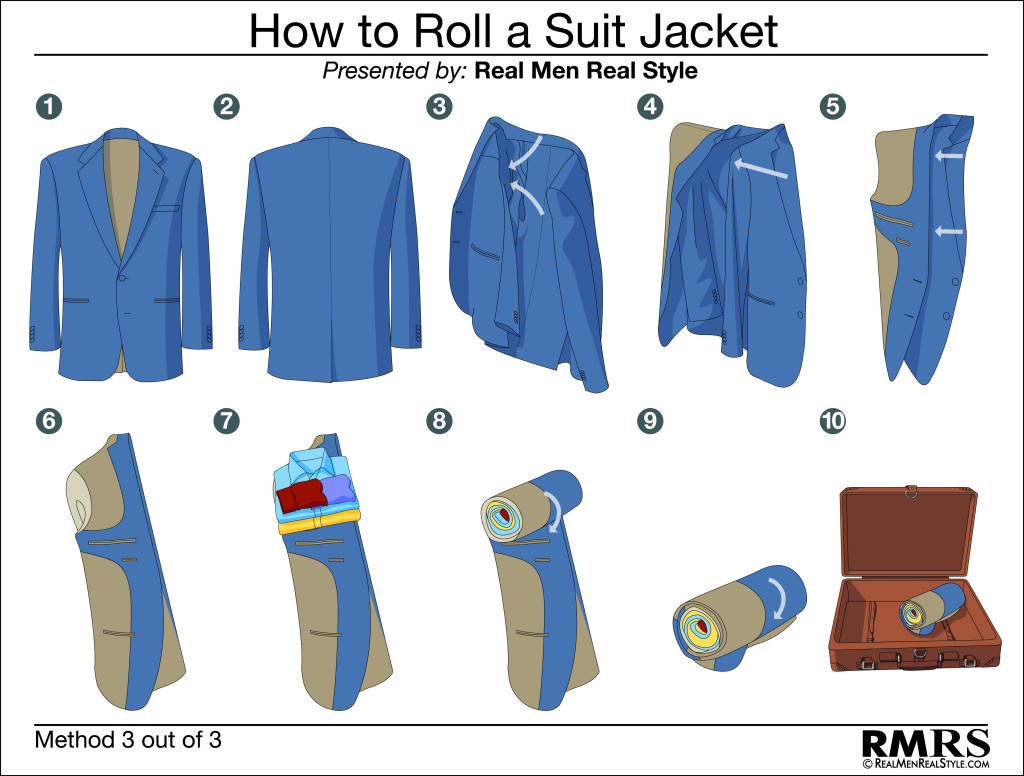Transporting a Jacket – Steps You Can Always Take

However you fold and store your jackets (more on that in a minute), there are a couple of ways to always minimize the damage to it:
- First off, avoid folding the jacket at all. If you’re flying, wear at least one of your jackets onto the plane so that you don’t have to pack it at all, apart from maybe a couple hours in the overhead.
- Whenever possible, use a full-length garment bag and keep the jacket on a hanger. These work on airplanes or in cars, but they’re limited in carrying capacity.
- If you do have to fold, minimize the number of folds needed, and try to keep them along the seams. The less you have to fold across a flat plane of fabric, the better.
- Where possible, stow the jacket with the lining facing outward, not the surface. If the lining gets scuffed, stained, or torn in transport, it won’t show when you’re wearing it, whereas damage on the outside can ruin the jacket, or at least require immediate repair.
It doesn’t do anything about the bulk (we’ll show you some creative folds in a minute that will help with that), but treating the jacket gently in the first place, no matter what you’re doing, can help it get to its destination crease-free and ready to wear.
How To Fold A Suit Jacket – 3 Ways To Pack Sports Jackets & Suits
As far as clothing maintenance goes, packing and transporting men’s suit and sports jackets is pretty high on the list of aggravating tasks.
A good wool jacket combines two major problems when it’s not on your shoulders: it’s bulky, and it’s vulnerable to permanent creasing if a fold gets pressed into the fabric. You can steam or iron those out later, in most cases, but it’s still extra work, and hard on the jacket’s longevity.
It’s a problem that cries out for a solution. Fortunately, we have three for you.

That said, you often have to fold a jacket to get it into a suitcase — especially when space is very limited — and a flat fold is sometimes the only way to go. This one’s better than most, and reduces the number of folds that aren’t on seams to one.
Basically, you gently work one shoulder inside-out, then tuck the other shoulder into it, seam against seam. The sleeves lie straight down the jacket, one on top of the other, and the breast panels (with their linings turned outward) sandwich the whole thing. Then you fold it in half from the bottom and pack it away.
This one’s good for when you need a flatter fold than a roll and the jacket is going to be stowed for a while. If you’re good about not stacking too much weight on it, the crease down the middle shouldn’t set, and you’ve got the jacket lining protecting the outside of the jacket from any wear or tear.
Its big disadvantage, other than the single fold that can potentially crease, is that it can take a couple tries to get it right, and that you generally need a clean flat surface to do it on. It can be done standing and holding the jacket, but it’s tricky.

The sleeves tuck behind the back, with the shoulders overlapping slightly at the middle, and the whole thing gets folded in half from the bottom, tucking the bottom hem up underneath the collar. The lapels and collar sit right on top, and you get a pretty neat square shape.
The resulting bundle is about the same size as the one you get in Option #2, but a little thicker in the middle and not quite as even.
The big problem here is that you’re folding the jacket in several places, both vertically and horizontally. That’s a good way to get at least some creases, especially where the folds cross each other.
So why bother mentioning it? It’s a lot quicker to throw together than the other two folds, and it’s easy to do without a flat surface. You just tuck the collar of the jacket under your chin and make three quick folds, and bam, you’re done.
If you know you’re just going to be throwing the jacket on top of a case for a short period, this’ll work just fine. For longer travel, or if it’s going to have weight pressing down on it, you’re better off with one of the other methods.

To get the least number of folds possible, there’s an easy solution: don’t fold the jacket at all.
You still need to do some creative tucking and layering, but it is possible to roll the whole jacket up (rather like a sleeping blanket or sleeping pad) into a soft tube of fabric.
The big advantage here is that, properly done, a rolled jacket is never folded across the fabric. Most of the action happens around the shoulders and sleeves, which are made to flex, and the broad front and back panels of the jacket get bent gently into a curve rather than pressed flat into a corner.
You can also usually tuck a shirt or a couple pairs of underwear into the roll, if you’ve got a deep enough suitcase. Just don’t try to cram too much in there — the roll won’t hold as well, and you’ll be more likely to wrinkle your jacket in the process.
The main disadvantage of a roll is that it takes up more space (especially vertical space) than a flat fold, and that it can sometimes take a few tries to get it right with no wrinkles.
And remember, you need to take those extra tries — if you force the jacket into storage with interior wrinkles, they’re likely to crease.
Read more at: http://www.realmenrealstyle.com/how-to-fold-suit-jacket-3-ways/
It’s a problem that cries out for a solution. Fortunately, we have three for you.

Jacket Fold Style #1 - Tucked-Shoulder Fold
This one does involve a large fold down the center of the jacket, meaning it’s not quite as crease-proof as a good roll.That said, you often have to fold a jacket to get it into a suitcase — especially when space is very limited — and a flat fold is sometimes the only way to go. This one’s better than most, and reduces the number of folds that aren’t on seams to one.
Basically, you gently work one shoulder inside-out, then tuck the other shoulder into it, seam against seam. The sleeves lie straight down the jacket, one on top of the other, and the breast panels (with their linings turned outward) sandwich the whole thing. Then you fold it in half from the bottom and pack it away.
This one’s good for when you need a flatter fold than a roll and the jacket is going to be stowed for a while. If you’re good about not stacking too much weight on it, the crease down the middle shouldn’t set, and you’ve got the jacket lining protecting the outside of the jacket from any wear or tear.
Its big disadvantage, other than the single fold that can potentially crease, is that it can take a couple tries to get it right, and that you generally need a clean flat surface to do it on. It can be done standing and holding the jacket, but it’s tricky.

Jacket Fold Style #2 - The Shirt-Style Fold
For the guy on the go, sometimes the easiest way to deal with the jacket is just to quickly fold it over like a dress shirt.The sleeves tuck behind the back, with the shoulders overlapping slightly at the middle, and the whole thing gets folded in half from the bottom, tucking the bottom hem up underneath the collar. The lapels and collar sit right on top, and you get a pretty neat square shape.
The resulting bundle is about the same size as the one you get in Option #2, but a little thicker in the middle and not quite as even.
The big problem here is that you’re folding the jacket in several places, both vertically and horizontally. That’s a good way to get at least some creases, especially where the folds cross each other.
So why bother mentioning it? It’s a lot quicker to throw together than the other two folds, and it’s easy to do without a flat surface. You just tuck the collar of the jacket under your chin and make three quick folds, and bam, you’re done.
If you know you’re just going to be throwing the jacket on top of a case for a short period, this’ll work just fine. For longer travel, or if it’s going to have weight pressing down on it, you’re better off with one of the other methods.

Jacket Fold Style #3 – The Jacket Roll
My personal favorite!To get the least number of folds possible, there’s an easy solution: don’t fold the jacket at all.
You still need to do some creative tucking and layering, but it is possible to roll the whole jacket up (rather like a sleeping blanket or sleeping pad) into a soft tube of fabric.
The big advantage here is that, properly done, a rolled jacket is never folded across the fabric. Most of the action happens around the shoulders and sleeves, which are made to flex, and the broad front and back panels of the jacket get bent gently into a curve rather than pressed flat into a corner.
You can also usually tuck a shirt or a couple pairs of underwear into the roll, if you’ve got a deep enough suitcase. Just don’t try to cram too much in there — the roll won’t hold as well, and you’ll be more likely to wrinkle your jacket in the process.
The main disadvantage of a roll is that it takes up more space (especially vertical space) than a flat fold, and that it can sometimes take a few tries to get it right with no wrinkles.
And remember, you need to take those extra tries — if you force the jacket into storage with interior wrinkles, they’re likely to crease.
Read more at: http://www.realmenrealstyle.com/how-to-fold-suit-jacket-3-ways/
No comments:
Post a Comment